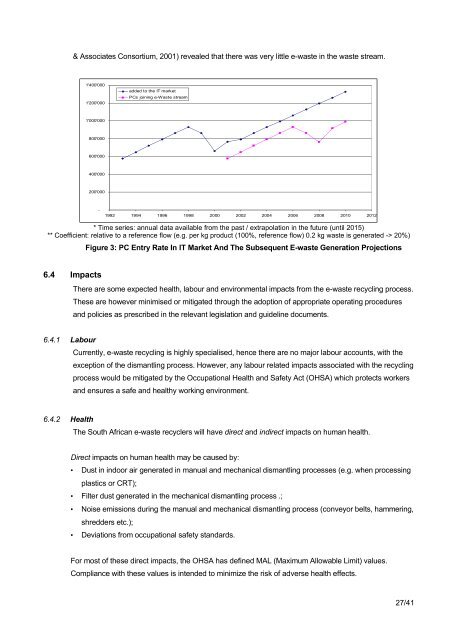E-WASTE ASSESSMENT IN SOUTH AFRICA - e-Waste. This guide
E-WASTE ASSESSMENT IN SOUTH AFRICA - e-Waste. This guide
E-WASTE ASSESSMENT IN SOUTH AFRICA - e-Waste. This guide
Create successful ePaper yourself
Turn your PDF publications into a flip-book with our unique Google optimized e-Paper software.
& Associates Consortium, 2001) revealed that there was very little e-waste in the waste stream.1'400'0001'200'000added to the IT marketPCs joining e-<strong>Waste</strong> stream1'000'000800'000600'000400'000200'000-1992 1994 1996 1998 2000 2002 2004 2006 2008 2010 2012* Time series: annual data available from the past / extrapolation in the future (until 2015)** Coefficient: relative to a reference flow (e.g. per kg product (100%, reference flow) 0.2 kg waste is generated -> 20%)Figure 3: PC Entry Rate In IT Market And The Subsequent E-waste Generation Projections6.4 ImpactsThere are some expected health, labour and environmental impacts from the e-waste recycling process.These are however minimised or mitigated through the adoption of appropriate operating proceduresand policies as prescribed in the relevant legislation and <strong>guide</strong>line documents.6.4.1 LabourCurrently, e-waste recycling is highly specialised, hence there are no major labour accounts, with theexception of the dismantling process. However, any labour related impacts associated with the recyclingprocess would be mitigated by the Occupational Health and Safety Act (OHSA) which protects workersand ensures a safe and healthy working environment.6.4.2 HealthThe South African e-waste recyclers will have direct and indirect impacts on human health.Direct impacts on human health may be caused by:• Dust in indoor air generated in manual and mechanical dismantling processes (e.g. when processingplastics or CRT);• Filter dust generated in the mechanical dismantling process .;• Noise emissions during the manual and mechanical dismantling process (conveyor belts, hammering,shredders etc.);• Deviations from occupational safety standards.For most of these direct impacts, the OHSA has defined MAL (Maximum Allowable Limit) values.Compliance with these values is intended to minimize the risk of adverse health effects.27/41
















